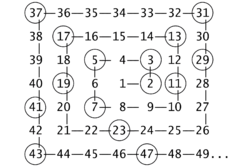-- -- --
-from Wikipedia:
"The Ulam spiral, or prime spiral (in other languages also called the Ulam cloth) is a simple method of graphing the prime numbers that reveals a pattern which has never been fully explained. It was discovered by the mathematician Stanisław Ulam in 1963, while doodling on scratch paper at a scientific meeting. Ulam, bored that day, wrote down a regular grid of numbers, starting with 1 at the center, and spiraling out:
He then circled all of the prime numbers and he got the following picture:
To his surprise, the circled numbers tended to line up along diagonal lines."-Then I clicked on Wiki's Sack's Spiral link:
"It differs from Ulam's in three ways: it places points on an Archimedean spiral rather than the square spiral used by Ulam, it places zero in the center of the spiral, and it makes a full rotation for each perfect square while the Ulam spiral places two squares per rotation. Certain curves originating from the origin appear to be unusually dense in prime numbers [...] The extent to which the number spiral's curves are predictive of large primes and composites remains unknown."

I don't understand anything of what they're talking about ... it's just that the Stargate effect in the "Beyond the Infinite" segment of Kubrick's 2001: A Space Odyssey kinda resembles Sack's Spiral, doesn't it?




